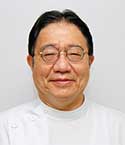Orthopaedics
Overview of the department

Chairman
Prof.
Akihiko Matsumine
Consultation system/therapeutic strategies
We specialize in all diseases in the field of orthopedics/spine surgery. Patients are treated using specialized knowledge, advanced techniques, and extensive experience. Our basic principle is to provide consistent medical services involving diagnosis, treatment, and rehabilitation in cooperation with practitioners in the area, and not solely treat patients with diseases. Based on this, effective medical services can be provided for patients with various disorders.
Advanced medical practice
Field of vertebral/spinal surgery
Clinical/basic research, involving the clinico-neurology and clinico-pathology of vertebral/spinal diseases, cell biology of spinal motoneurons/tissue repair, pathology/cell biology of vertebral ligament ossification, and molecular biology of intervertebral disks, is positively conducted. Advanced medical care based on these areas is provided. Artificial vertebral bodies specifically for Japanese have been developed, and satisfactory results have been obtained. Furthermore, clinical, multicenter, epidemiological, and basic studies regarding “spinal plasticization and function” are being conducted by the Survey Research Group regarding Ossification of the Spinal Ligament (chief investigator, Uchida), Scientific Research Grant/Subsidy-assisted Specific Disease Control Business by the Ministry of Health, Labour and Welfare.
Field of articular surgery
The development of hip prostheses specifically for Japanese and a biodynamic study of these products have been continuously performed. The use of these hip prostheses has facilitated strong, initial fixation, making gait from 2 days after surgery possible. Furthermore, the mid-/long-term results of hip prostheses have been markedly improved, satisfying patients. In patients with marked deformity or bone defects, highly accurate, safe surgery is performed by introducing a computer navigation system.
Treatment of patients with rheumatoid arthritis
Rheumatoid arthritis treatment has markedly advanced with the appearance of biological preparations. These drugs reduce articular inflammation/pain and cartilage destruction. When articular deformity is advanced, functional disorder may affect daily living; therefore, surgery to improve the articular function is necessary. Optimal treatment is performed in accordance with individual patients’ conditions by effectively combining these biological preparations with surgery.
Treatment of patients with pelvic trauma
Although advanced knowledge, techniques, and experience are required, initial treatment, surgery, and rehabilitation are positively conducted by sufficiently trained staff. Satisfactory treatment results have been obtained. All types of trauma other than pelvic trauma are managed as emergencies.
Ultrasonic fracture treatment, which has been covered by health insurance only for patients with refractory fracture, can be performed in patients with all types of fracture treated by invasive surgery, as advanced medical practice, to shorten the bone assimilation period and decrease the incidence of delayed cure.
Sports orthopedics
It is important to achieve rehabilitation to facilitate daily living activities and return the physical level to the pre-injury state. For these purposes, staff with specialized knowledge and rehabilitation activities play important roles. Athletic rehabilitation is conducted in accordance with individual patients’ physical levels by analyzing sports activities and those on walking and introducing joint-/muscle strength-analyzing instruments. Hand surgery
Tendon transfer, tendon transplantation, and microsurgery for hand dysfunction related to trauma are performed.
Primary examinations
Intraoperative spinal cord monitoring, navigation system
Spinal cord monitoring during vertebral/spinal surgery and surgery-assisting endoscopy/navigation systems are introduced, facilitating safer, minimally invasive surgery.
Various diagnostic imaging procedures
It is possible to diagnose vertebral/spinal, articular, and tumorous diseases at an early stage using high-resolution MRI, 3D-CT, and PET. Accurate surgical treatment can be performed.
 University of Fukui Hospital
University of Fukui Hospital University of Fukui Hospital
University of Fukui Hospital +81-776-61-311
+81-776-61-311 Access
Access